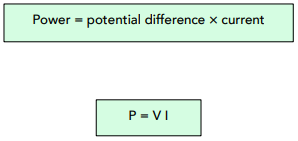Power: Current and Potential Difference (GCSE Physics)
Power: Current and Potential Difference
Power
The power of an appliance is the amount of energy (J) that it transfers per second.
In other words, power is the rate of energy transfer.
Power is measured in Watts (W).
1W means 1J of energy transferred in 1 second.
Calculating Power
Using Current and Potential Difference
We can calculate power in one of two ways. Firstly, we can use potential difference and current.
Remember, current tells us the rate of movement of charge. Whilst potential difference tells us the energy transferred per unit charge. Therefore to find the total energy transferred per second, power, you need to multiply current by voltage.

Where:
- power, P, in watts, W
- potential difference, V, in volts, V
- current, I, in amperes, A
Power is measured in Watts (W). 1W means 1J of energy transferred in 1 second.
Question: Billy is using a lamp. The current in the lamp is 0.4A, and the potential difference across the lamp is 5V. Calculate the power supplied to the lamp.
1. Write out the appropriate equation.
P = VI
2. Substitute in the numbers.
P = 5 x 0.4
P = 2 W
Question: There is just one bulb and one cell in a series circuit. The cell provides a voltage of 6V. A current of 3A flows in the circuit. What is the power of the bulb?
The bulb is the only component, so gets the maximum voltage of 6V.
Power = Current x Voltage = 3 x 6 = 18W
Question: An electric fire has a power of 1.25kW and a potential difference of 210V. Fuses are available in the standard ratings of 2A, 5A and 10A. Which would be the best fuse to use?
1. Write out and rearrange the appropriate equation.
P = VI
I = P / V
2. Calculate the current.
I = P / V
I = 1250 / 210 = 5.9523
I = 5.95 A
3. Determine which fuse to use.
Now we have calculated the current, we can see that the best
fuse to use would be the 10A fuse as the other fuses would blow
as their values are too low.
Power is the rate at which energy is transferred. It is a measure of how much work is being done in a certain amount of time. Power is often expressed in units of watts (W).
The formula for power is P = IV, where P is power, I is current, and V is voltage or potential difference.
Current is the flow of electric charge. It is measured in units of amperes (A). The flow of current is like the flow of water in a river. Just as a river can have a strong or weak flow, an electrical current can be strong or weak.
Potential difference, also known as voltage, is the force that drives the flow of electric charge. It is measured in units of volts (V). The potential difference between two points is like the height difference between two points in a river. The greater the height difference, the greater the flow of water. Similarly, the greater the potential difference, the greater the flow of electric charge.
Current and potential difference are related to power in that power is equal to the product of current and potential difference. The more current flowing through a circuit, and the greater the potential difference, the more power is transferred.
The amount of energy transferred depends on both the power and the amount of time for which the energy is transferred. The higher the power, the more energy is transferred in a given amount of time.
An example of power in everyday life is a light bulb. The higher the power rating of a light bulb, the brighter it will be. The amount of energy used by a light bulb depends on both the power rating and the amount of time for which it is used.
Understanding power, current, and potential difference is important because they are fundamental concepts in electricity and electronics. These concepts are used in many everyday appliances and in many industries, including construction, manufacturing, and telecommunications. By understanding these concepts, you can better understand how electrical devices and systems work.





Still got a question? Leave a comment
Leave a comment